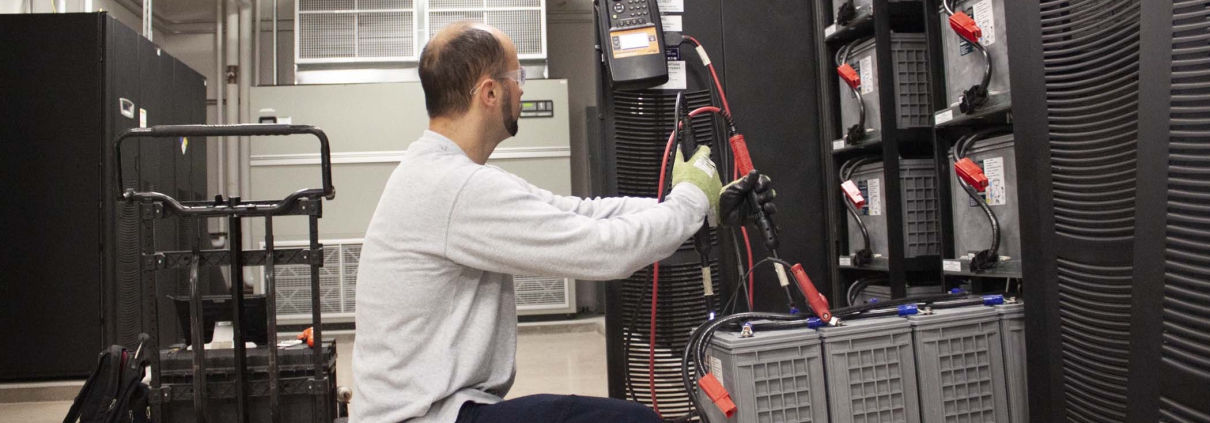How Does a Data Center Battery Backup Work?
Introduction
Data centers are the backbone of today’s digital world, powering everything from cloud services to online transactions. Any interruption in power can lead to data loss, downtime, and significant financial impact. To ensure continuous operation, data centers rely on battery backup systems that provide emergency power the instant the main supply fails.
This article explains how data center battery backups work, the types of batteries commonly used, key factors influencing backup performance, and the future trends shaping this critical technology.
- What Is a Data Center Battery Backup System?
A data center battery backup system is typically integrated with an Uninterruptible Power Supply (UPS). The battery acts as a short-term energy reservoir, ensuring that critical IT equipment continues running without interruption during power outages.
While diesel generators provide longer-term backup, batteries are the first line of defense. They fill the gap between the loss of utility power and the moment backup generators come online, preventing even a fraction-of-a-second interruption.
- How a Data Center Battery Backup Works (Step-by-Step)
Normal Operation:
- Under normal conditions, utility power supplies the data center.
- The UPS keeps the battery fully charged and ready, monitoring voltage and load conditions.
Power Outage:
- When the main power fails, the UPS instantly switches to battery power.
- The transition is seamless, typically in milliseconds, ensuring servers and networking equipment remain online.
Generator Start-Up:
- Batteries can only sustain load for a limited duration, usually a few minutes.
- During this period, diesel or gas generators start and stabilize.
- Once generator power is available, the load is transferred from the battery to the generator.
Power Restoration:
- After utility power is restored, the UPS switches back to normal operation, and batteries are recharged to prepare for the next potential outage.
Visual diagrams of this process can help operators understand the precise sequence of events and handoff between systems.
- Types of Batteries Used in Data Centers
VRLA (Valve-Regulated Lead-Acid) Batteries:
- Widely used due to low upfront costs.
- Pros: Mature technology, easy to source.
- Cons: Limited lifespan, bulky, require temperature control and maintenance.
Lithium-Ion Batteries:
- Increasingly adopted for modern data centers.
- Pros: Longer lifespan, higher energy density, lighter, better thermal performance.
- Cons: Higher initial investment, but lower total cost over lifecycle.
Differentiation Tip:
When evaluating batteries, consider Total Cost of Ownership (TCO) rather than upfront cost alone. Lithium often outperforms lead-acid over the long term, especially in high-demand or space-constrained environments.
- Backup Duration and Key Influencing Factors
- Typical backup time: 5–15 minutes, sufficient to start generators and prevent service interruption.
- Factors affecting duration:
- Battery capacity
- Total connected load (servers, networking, cooling)
- Redundancy and parallel configuration
- Batteries are not designed for long-term power supply—they are short-term bridges, buying time for generator activation.
- Why Data Center Battery Backup Is Essential
- Prevents Data Loss: Ensures continuous operation of servers and storage systems.
- Maintains SLA Commitments: Avoids downtime penalties and protects customer trust.
- Compliance and Safety: Critical for industries with regulatory requirements such as finance, healthcare, and government.
Even brief interruptions can cause cascading failures, so reliable battery backups are essential for operational resilience.
- Future-Proofing: From Lead-Acid to Lithium
The data center industry is rapidly shifting toward lithium-ion batteries. Advantages include:
- Longer lifecycle, reducing replacement frequency
- Better energy efficiency and space utilization
- Improved thermal performance and safety
👉 For a deeper dive into the evolution of UPS batteries and key considerations for the future, check out this article:
Data Center UPS Batteries: Evolution, Key Considerations, and Future Trends
This shift is especially relevant for modern data centers seeking higher density, lower maintenance, and longer-lasting solutions.
- Choosing the Right UPS Battery Solution
Selecting the right battery involves balancing:
- Load requirements and redundancy
- Budget constraints
- Operational complexity and maintenance capability
- Future scalability
🔹 If you’re looking for short-time backup power solutions tailored for data center UPS applications, you can explore detailed product options here:
PU UPS Short-Time Backup Power Series
By aligning battery choice with operational goals, data centers can ensure both reliability and cost efficiency.
Conclusion
Battery backups are the first line of defense against power interruptions in data centers. They provide instant, reliable power to critical equipment while generators take over, safeguarding data integrity and service continuity.
Understanding how battery backups work, the types of batteries available, and the factors influencing performance helps data center operators make smarter decisions. With the ongoing transition from lead-acid to lithium-ion, modern facilities can achieve higher efficiency, longer battery life, and reduced maintenance—ensuring resilient operations for years to come.


